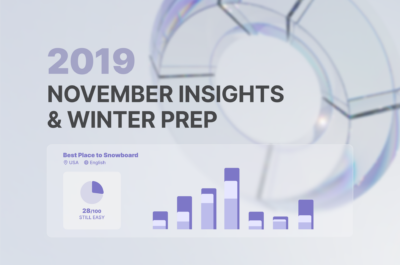Search intent – how to understand user needs?
Search intent is one of the most important factors affecting a website’s positioning in search results. In recent years, Google’s algorithms have undergone significant changes, and understanding user intent has become more important than ever. In this article, we will discuss what search intent is, how to classify it, and how to tailor website content […]

Search intent is one of the most important factors affecting a website’s positioning in search results. In recent years, Google’s algorithms have undergone significant changes, and understanding user intent has become more important than ever. In this article, we will discuss what search intent is, how to classify it, and how to tailor website content to match it.
What is search intent and why is it important in the SEO process?
Search intent in SEO refers to the motivation of a user who types a specific query into a search engine. Depending on the search intent, a user may be looking for specific information, products to buy, services to use, or solutions to their problems.
To be successful in SEO, it is not enough to simply optimize a website for selected keywords. When creating an SEO strategy, we should first and foremost understand the user’s search intent. This will allow us to create valuable content that addresses their specific, defined needs.
Content on a website that is properly tailored to user intent not only has a positive impact on its position in search engine results, but also on its overall functionality and attractiveness from the user’s perspective. When a site contains valuable and tailored content, users are more likely to stay on the site longer, browse more subpages, and return to such a site in the future.
In addition, using properly selected keywords that respond to user intent, as well as tailoring the structure of the site to those intentions, can help increase traffic to the site.
Understanding search intent and creating valuable content are key elements of an effective SEO strategy.
What are the types of search intent?
There are four types of search intent in SEO. These are:
Informational intent
This means that the user is looking for information on a specific topic or a solution to a problem. The user may be looking for answers to questions, advice, or knowledge on a specific topic.
Examples of informational searches:
- “how to lose weight?”
- “what is SEO?”
- “best vacation spots”
- “fashion trends for the spring-summer 2023 season”
Navigational intent
Navigational Intent Navigational intent refers to a situation where a user already knows the specific name of a website or brand and searches for it to go directly to the site. Navigational intent often occurs after a previous interaction with a particular brand, such as seeing an ad or receiving a recommendation from a friend.
Examples of navigational searches:
- “Facebook login”
- “Insightland Company”
- “Gmail”
Transactional intent
Transactional intent refers to a situation where a user is searching for a specific product or service with the intention of making a transaction. At this stage, the user is looking for the most attractive deal and the store where they can complete the transaction.
Examples of transactional searches:
- “iPhone 13 Pro”
- “Dell Laptop”
- “SEO Agency Wrocław”
Commercial investigation
Users are looking for information about products or services, but are not yet ready to make a purchase. Users with commercial intent are still considering a purchase and are trying to find information about different options, prices, user reviews, or product/service comparisons.
Examples of commercial searches:
- “smartphone comparison”
- “best family car ranking”
- “which TV to choose”
How to verify search intent for a given keyword?
Every user has their own way of searching for products, services or information, so we cannot rely solely on our own experiences and opinions. So, how can we verify the search intent for a given keyword?
Google search engine can be very helpful in this process. We can use it to check the search intent for selected keywords. This ensures that the keywords we have chosen are actually relevant to the users’ needs and that our SEO strategy will be effective.
By analyzing search results, we can verify what appears in the search results for a given keyword – be it product pages, blog articles, local results, or videos. This helps us understand what types of content are most relevant to a particular query.
Here’s an example of verifying search intent in the Google search engine for the phrase “elegant summer shoes”:

Despite the sales-oriented tone of the phrase, the first 3 results in the SERPs are informative articles, while the category page ranks 4th.
Optimizing the category page for this phrase is unlikely to yield the desired results in terms of increased sales because (as the analysis demonstrated) Google prioritizes informational content for this phrase and treats it as an informational query. To provide the user with the most relevant results that match their intent, the site should feature a blog post that provides the information the user is looking for.
To verify the user’s intent, we can also use a tool like Semrush. This data can be found in the “Keyword Overview” tab.

By following these steps, we can gain a better understanding of users’ search intent for a given phrase and tailor our SEO efforts to meet their needs.
However, it’s important to keep in mind that search intent is not static and can change over time as Google strives to understand the true purpose behind each search.
How to optimize content for different user intents?
To tailor your site’s content to user intent and improve your site’s visibility in organic search results, follow these steps:
- Verify and determine search intent – understand the purpose behind a specific user query, analyze the queries users type in, and select the most relevant keywords to match their needs.
- Prepare content that addresses the user’s objective – after identifying the search intent, we should create content that answers specific questions or problems. The content should be valuable and written in a way that is clear and understandable to the user.
- Optimize content for selected keywords – keywords should be relevant to the search intent and then placed in headings, content and meta tags on the page. Remember to incorporate keywords into the content in a natural, non-intrusive way.
- Use different types of content – it’s worth using different types of content, such as articles, rankings, infographics, or videos, to address different user questions and problems. For example, if a user is looking for information about a specific product, it’s helpful to prepare content in the form of a review or comparison, while a how-to article is appropriate if a user is looking for problem-solving solutions.
- Tailor content to the specific stage of the sales funnel – users may be at different stages of the sales funnel and looking for different types of information. It pays to tailor content to the stage the user is at.
- Use internal linking – internal links to other pages on your website allow users to find additional information on a particular topic or to move to the next stage of the sales funnel.
- Ensure a positive user experience – the site should be easy to navigate and load quickly, and information should be easily accessible and understandable to users.
Summary
Search intent is one of the most important factors in website positioning. Understanding users’ needs and tailoring the content and structure of the page to their intentions can significantly improve the site’s visibility in search results and boost traffic.


